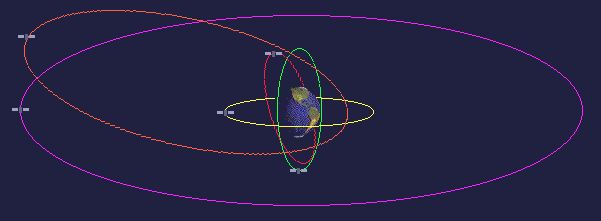![]()
Surprising as it may seem, after a satellite is launched into space, it needs little to no power to keep it moving. Satellites move in a path around the Earth called an orbit. Every satellite must have an orbital path (remember, satellites that travel into deep space to look at distant planets are not true satellites, they are in fact space probes), and the type of path it takes is determined by the physics involved.

A satellite's orbit works because of a balance between two forces. The orbit is a combination of the satellite's velocity - the speed it is travelling in a straight line - and the force of the Earth's gravitational pull on the satellite. These forces are similar to the forces that keep all the planets in their places in the solar system. That gravitational pull is the result of the mass or weight of the Earth and the mass of the satellite. Basically, gravity keeps the satellite's velocity from sending the satellite flying out in a straight line away from the Earth, and the satellite's velocity keeps the force of gravity from pulling the satellite back to Earth.
To illustrate this concept, think of a yo-yo. There is a long string that holds the weight of the yo-yo ball at the end. The yo-yo ball is the satellite, and your hand holding the end of the string is the Earth (not to scale of course). If you swung that yo-yo in a circle, then the string would act as the gravity. Without the string, the yo-yo ball would fly off into space, but without the weight and forward motion of the yo-yo ball, the string would flop towards the ground.
Since the Earth turns from west to east on its axis, satellites can either seem, from Earth, to be moving very quickly or very slowly. A satellite in orbit travelling towards the east would seem to be moving very slowly to an observer on Earth. On the other hand, a satellite moving toward the west would seem to be moving quickly to someone on Earth. From Earth, there is only one orbit that would seem like it wasn't moving, and that's a geostationary orbit, also know as geosynchronous.
The advantage of having a satellite in one orbit rather than another orbit usually depends on its inclination - the angle at which a satellite's orbit is tilted in relation to the Earth's equator. When engineers are designing a satellite, and designing its function, they must choose an orbit that is appropriate to its function. So, a satellite that is in an orbit very high up will not be able to see objects on Earth in as much detail as orbits that are lower, and closer to the Earth's surface. Similarly, the speed of the satellite moving in the orbit, the angle over the Earth the satellite takes, the areas which the satellite can observe, and the frequency with which the satellite passes over the same portions of the Earth are all important factors to consider when choosing an orbit.
Finally, the place from which a satellite is launched is important in determining its orbit. For example, a satellite launched from NASA's launchpad in Cape Canaveral, Florida has a lesser degree of inclination, so it is not tilted very far off from the line of the equator. A satellite launched from a place with a higher latitude, like Canada, would have a higher angle of inclination, so satellites launched into polar orbits might be launched from somewhere as far north as Canada. To put a satellite into equatorial orbit, for example, it would be best to launch it from somewhere close to the equator. Often, NASA launches its rockets carrying satellites into equatorial and geostationary orbit from a launchpad in French Guyana.
Essentially, there are two major divisions in orbit types; there are circular and there are elliptical orbits. Circular orbits comprise: geostationary, polar, sun-synchronous, and equatorial orbits. Highly elliptical orbits come in all different shapes and sizes. Orbits of different shapes have different eccentricities.